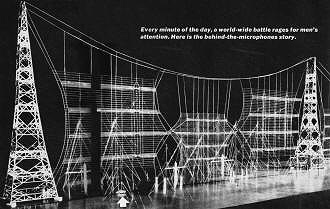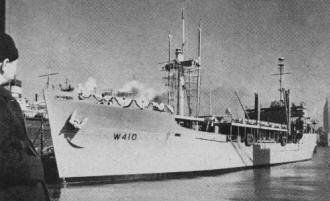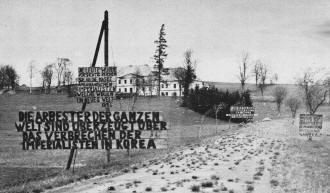|
May 1952 Popular Science
 [Table of Contents] [Table of Contents]
Wax nostalgic about and learn from the history of early
electronics. See articles from
Popular
Science, published 1872-2021. All copyrights hereby acknowledged.
|
Post-Millennials have not
known of a time when instant, ubiquitous communication was not available between
nearly any two points on Earth. The rest of us remember when placing a phone
call while on the go required finding a telephone booth and dropping in the
required amount of pocket change. In the 1970s, when I would have made my first
pay phone call, most people my age did not have a credit card to use for having
an operator place a call when enough dimes and quarters were not on-hand. My
first credit card, gotten sometime around 1979-1980, was from Sears, and it
could not be used anyplace other than Sears. My first "major" card was a Visa,
issued in 1983. Back then, you needed to prove the ability to pay your bill
before you would be trusted with a credit card ... but I digress. Prior to the
turn of the century, mobile communications consisted mainly of Citizens Band
(CB) radio and Amateur (Ham) radio. Limited range and sometime crowded channels
on CB meant contacting fellow "good buddies" was a shot in the dark. Hams signals
could go much farther distances, but the number of available contacts was much more
limited. People living in Communist countries were often nearly impossible to
reach because their oppressive governments prohibited even receiving foreign
"propaganda" signals - under threat of imprisonment and/or fines (like where
even today the Nazi state of
Virginia prohibits the reception of police radar gun transmissions).
Accordingly, the U.S. government used extreme measures to broadcast messages of
Western world freedom (which we are losing rapidly) to the oppressed masses.
This "How We Fight with Words" article from a 1952 issue of Popular
Science magazine discusses some of the methods employed, including some
darn large antenna arrays.
How We Fight with Words

Curtain Antennas two city blocks long, with towers 289 and 249
feet high, will soon give the U. S. the loudest radio voice in the world. Ten such
antennas are in use or being built. This model, with a toy car in scale, shows how
they will look.
Wesley S. Griswold
Not long ago the U. S. launched a new kind of battleship - a Coast Guard cutter
armed with the most powerful radio transmitters that ever went to sea. The 5,800-ton,
338-foot Courier sailed off to a secret destination, but there was no secrecy about
its mission. It is the country's latest weapon in the cold war of the air waves
between the leading democracies and the Communist nations.
Flying its main antenna from a captive barrage balloon filled with helium, the
Courier will anchor in friendly foreign ports as close to Russia as possible. From
there its 150,000-watt medium-wave transmitter and two 35,000-watt short-wave transmitters
will lob explosive messages of truth over the Iron Curtain.
Congress has been asked to provide the money for two more ships like the Courier
but with greatly increased transmitting power. Meanwhile, the U. S. fires most of
its radio guns from home soil - 44 transmitters, ranging in power from 50,000 to
200,000 watts, located in Massachusetts, New York, New Jersey, Ohio and California.
Others are being forged, to be set up in North Carolina and the State of Washington.
Every minute of the day, a world-wide battle rages for men's attention. Here
is the behind-the-microphones story.
Air War Rages over Europe

"A New Kind of Weapon for a new kind of beach-head," the Courier,
loaded with radio transmitters and secret electronic equipment, has sailed off to
help work out ways to overcome Russian jamming.

Plan of Campaign is to reach 340,000,000 pairs of ears, the estimated
number of radio listeners outside North America. Map shows areas that Voice of America
bombards with its 75 transmitters. Inset above shows areas that Radio Free Europe
peppers with its nine.
The answering fire from the Reds that reaches the 96,000,000 receiving sets of
North America is weak and spotty. The main battleground is in Europe, with secondary
engagements being fought in Asia. Skirmishes occur from time to time in Africa.
An occasional shot lands in South America and even in Australia.
In Europe, barrages and counter-barrages are continuous and fierce. There the
principal British and Russian battle lines are drawn, and the U. S. has moved up
29 transmitters to forward positions. Five of them are placed on the territory of
our ally, Great Britain. Thirteen are located in Germany, one in Greece, four in
Portugal and six in Tangier, just across the Strait of Gibraltar from Spain. More
are being built.
For popping propaganda shells into Asia, the U. S. has set up two transmitters
in Hawaii, four in the Philippines and one in Ceylon.
As ammunition, the Voice of America, which is the official and biggest U. S.
battle unit in the war of the air waves, chiefly uses straight news and dependable
intelligence reports of what is going on in Communist countries. It riddles the
latest Red distortions of facts by telling the truth. It also tells the world what
life here is like, and presents talks by leading citizens to explain what most Americans
believe in. It seasons the whole mixture with the favorite music of many nations.
Refugees Supply Ammunition
Radio Free Europe, next in importance on the U. S. side, has the advantage of
being unofficial and therefore able to fight rougher. It is a small and highly damaging
body of American commandos, supported entirely by private contributions, who concentrate
on Poland, Czechoslovakia, Hungary, Bulgaria, Romania and Albania.
Since RFE began broadcasting on July 4, 1950, it has made the fullest possible
use of anti-Communist refugees from the six Soviet satellite states of eastern Europe.
Escaped Hungarians talk to the Hungarians back home, Poles to Poles, Czechs to Czechs.
These people put the finger on Red agents and collaborators, reveal conditions that
the regimes are anxious to hide from their own people as well as from the world,
and do everything short of inciting armed revolt to weaken the power of the puppet
governments that Russia installed.
It is hard to tell which side is ahead in the cold war of the air because the
victories almost never win headlines. There have been a few striking exceptions.
When two Russian military pilots flew out of the Soviet Union to freedom in the
West, they said persuasive American and British broadcasts had convinced them that
they should try to escape. The Czechs who drove a train and its passengers across
the frontier between their captive country and West Germany said the same thing.
So did the Polish crew who sailed a mine sweeper to a safe haven in Sweden, and
the Czech boys, forced laborers of the Soviets, who dug their way out of a uranium
mine in East Germany and escaped.
Underground Stations Join Fight
The first evidence Radio Free Europe had that it was landing effective shots
in Communist territory came when the Russians began broadcasting threats to hang
every German they could get their hands on who had assisted Radio Free Europe in
any way.
Anti-Communist radio stations have been overheard rebroadcasting RFE information
inside Albania, Czechoslovakia, Hungary and Bulgaria. A mobile, unlicensed transmitter
calling itself Radio Free Russia, and concentrating on Soviet troops in East Germany
and Austria, started operating somewhere in western Germany a year ago.
Voice of America and Radio Free Europe campaign commanders obtain their best
reports on battle progress from letters. VOA mail has reached a volume of 40,000
letters a month, from both sides of the Iron Curtain. A Russian who recently escaped
to West Germany wrote VOA: "Your broadcasts undermine the Soviet regime and ...
are a weapon more powerful than the atom bomb."
After Radio Free Europe had accused 16 officials of the Ganz Electrical Works
in Budapest of being informers, it promptly received a letter from one of the workers
in the plant telling what happened:
"The Factory went wild. Commies were running in and out. Secret conferences were
held at all hours. And everyone was under suspicion. Morale sagged. Work practically
stopped everywhere. It was a darned fine job! It should be repeated - and often."
Another letter described how the inmates of a camp for political prisoners in
Czechoslovakia had managed to hide a short-wave transmitter in the camp dentist's
chair and broadcast accounts of what was going on in the camp to Radio Free Europe.
When RFE later repeated the accounts in broadcasts to Czechoslovakia, Communist
police tore the camp apart until they had tracked down and destroyed the telltale
transmitter.
Enemy's Tricks Are Exposed
A Hungarian wrote of an extraordinary effort that the Communist regime there
had made to discredit Radio Free Europe. RFE broadcasts had been telling how Red
big shots were wasting the people's money in riotous, costly evenings at a Budapest
club. One night, trucks and men suddenly descended on the club and completely removed
it. The next day, the Communist radio jeered at RFE and invited Hungarians to see
for themselves that no such club existed. The people of the neighborhood, however,
told the true story, with great satisfaction, to everyone who asked.
An old man in Budapest wrote Radio Free Europe that of the 60 families in the
apartment house where he lived at least 10 listened regularly, without fear, to
RFE broadcasts. He could hear the broadcasts himself clearly on his four-tube set,
he said.
With the aid of informants such as these, Radio Free Europe has been able to
warn the people of Bulgaria that government men coming around to collect waste were
frequently members of the secret police. It has been able to warn the Czechs of
the Communist practice of erecting false frontier posts near the real ones and manning
them with Red police in stolen American and German uniforms to trap citizens trying
to escape to West Germany.

This is the Iron Curtain. Propaganda signs in Red Czechoslovakia
face West Germans. Biggest sign reads "The world's workers well know the imperialists'
crimes in Korea."
Reds Broadcast Wolf Calls
The Communists have reacted on the air with screams of rage, calling the Americans
and British liars, cheats, wicked imperialists and bloody murderers at all hours
of the day. They distort the news to make it appear favorable to their cause, and
when this cannot be done convincingly, they omit it altogether.
Most of all, they try to prevent the Western voices from getting a word in edgewise.
Mobilizing a formidable battery of 1,250 transmitters, the Russians endeavor to
drown them out by continuously broadcasting Siberian wolf calls, the screaming of
sea gulls, the roar of airplane engines and the hum of electric motors.
To overcome this jamming, British and American radio engineers rely, first, on
the power, number and position of their transmitters. Whenever the budget allows,
they gain signal strength by stepping up transmitting power and improving antennas.
Occasionally they combine forces, using more than 70 transmitters simultaneously
to land signals of tremendous strength on predetermined spots in the target area.
Russians Jam Own Broadcasts
One of the most effective counter-jamming techniques is called "cuddling." It
is the process of beaming signals at Russia and her satellites on frequencies so
close to the ones they use for domestic broadcasts that the jammers cannot smother
the incoming signals without wiping out their own.
This is especially disruptive in Russia, for wire-transmission facilities are
so inadequate that the national radio network is of far greater importance than
it is in the leading Western countries. Newspapers in remote parts of Russia depend
on the radio for their news and the latest official propaganda line from Moscow.
Because of this, a really intensive jamming effort by Soviet radio engineers can
bring about a news blackout in their own country.
Another way in which British and American technicians outwit the jammers is by
bouncing signals off the ionosphere at a variety of angles so that they land in
a checkerboard pattern. The highly directional signals arrive on their downward
journey from the ionosphere with maximum intensity. There is no way in which the
jammers can tell where or when such a signal will land, and in order to drown it
out they must land a signal of equal or greater strength right on top of. it. This
is hard enough to do when the incoming signals are all landing in one area. When
they are arriving in a checkerboard pattern, the problem becomes enormous. There
are almost certain to be corners in each square where signals escape the jammers.
As a third device for penetrating the jamming defense, the Voice of America sends
news to Russia in Morse code eight hours a day, at a rate slow enough to suit even
a poor telegrapher. Code is far harder to jam than voice signals. It can be transmitted
over a much wider range of frequencies. It is an interrupted signal and therefore
harder to locate. Finally, while a weaker jamming signal can garble voice transmissions
effectively, it does not obscure code. An experienced wireless operator can "read"
the message right through the interference.
The Russians are impressively expert at jamming, but with all their transmitters
they cannot lay a thick blanket of noise over the immense distances of their land.
There are bound to be holes in the blanket. /p>
Voice of America officials estimated a year ago that the Russian people were
hearing about 20 percent of what the U. S. intended them to hear. The latest estimate
is that improved facilities and techniques have stepped that figure up to 40 percent.
More Receivers Needed
The entry of the Courier into the counter-jamming campaign may soon raise the
figure further. Besides being able to shift its position at will, it is equipped
with certain electronic devices for counteracting jamming, the details of which
are secret.
It would, of course, be a great advantage to the free countries if they could
place more radio receivers in the hands of the people behind the Iron Curtain. There
was an item of $2,800,000 in the original Voice of America budget for 1951 - the
one that Congress eventually cut 90 percent - which was intended to accomplish that.
For friendly countries, it proposed to provide large sets to be placed in taverns,
clubs, schools and other public gathering places. It also proposed to purchase radios
"of pocket size and operating on powerful miniature batteries of radically new design,"
which were "to be smuggled into countries where radio listening is the rough equivalent
of treason."
Many Ways to Smuggle
Sets of suitable size have been in existence for several years (PSM, March '48,
p. 132). The principal barrier to their use has been their cost. But a year ago
David Sarnoff of RCA said that he thought it was possible to make miniature receivers
for as little as two dollars apiece and that he had RCA engineers at work on the
project.
Smuggling them into Iron Curtain countries might be done by balloon, as Radio
Free Europe delivered propaganda pamphlets last year (PSM, Oct. '51, p.124), or
by methods developed during World War II. Then, British planes dropped tiny sets
to the Czechs in matchboxes. The Dutch hid them in cut-out books, lamps and women's
powder dusters. They even slipped one into a Nazi prison camp in a can of vegetables.
Posted September 14, 2023
|













